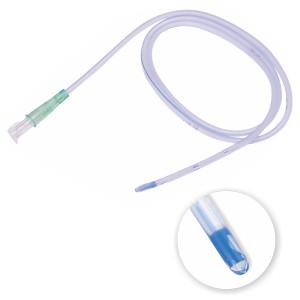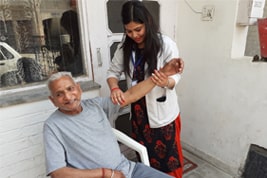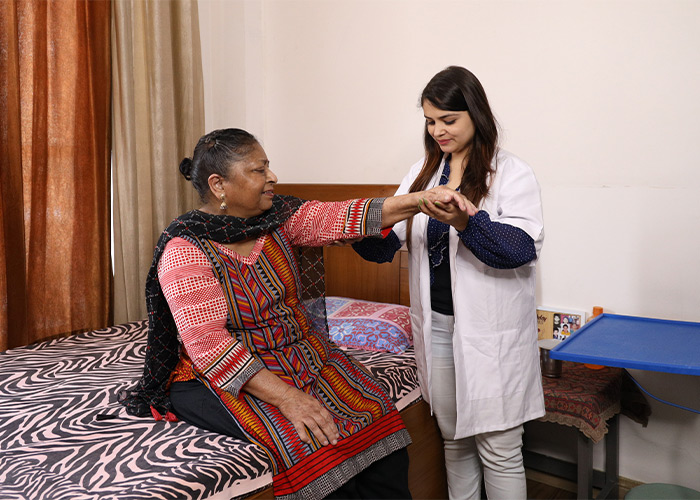RT feed is a nursing procedure to provide nutrition to those people who are either unable to obtain nutrition by mouth or are not in a state to swallow the food safely. So, the procedure of providing the entire feed using a feeding tube is termed as RT feed. In RT Feed a disposable polyvinyl chloride pre-sterile tube known as Ryle’s tube or RT is used. RT tube is used for both diagnostic as well as therapeutic purposes.

This method of tube feeding is applicable for all in need, from infants to the elderly. The main principle involved is providing easy to feed formulas via a tube. Proper training is provided to the home nurses for safe administration of food and medications via tubes like nasogastric, gastrostomy or orogastric.
Why and to whom RT Feed is provided?
RT feeding is given to the patients who are in an unconscious state, under low cranial nerve palsies, or incapable of mouth feeding due to some disease. There are dozens and dozens of health conditions that might lead to a dependency on tube feeding. The most common conditions wanting RT Feed as a necessity include:
– Prematurity births,
– Failure to thrive or even extreme malnutrition cases,
– Several neuromuscular and neurologic disorders,
– Severe inability to swallow food, etc.
Besides the health disorders, anatomical and some post-surgical malformations of the mouth and esophagus especially in oral cancer cases also require RT Feed. Method of feeding with a tube is mainly considered as a temporary solution to any unwanted crisis in the form of the disorder, post-surgery malformation or injury. But it is designed in a way that it can be used for the duration like from few days to weeks.
Although, switching the tube from one nostril to another becomes a mandatory thing periodically. Otherwise, it can cause some cuts in the nostril due to constant pressure buildup mainly when used for long durations. Besides several disorders some of the following patients also require intubation:
– A patient with facial and neck injuries or surgery
– A patient with intestinal blockage or obstruction
– A patient in a coma or on a mechanical ventilator for breathing
– A nasogastric intubation tube is also used during the treatment of accidental poisoning for suctioning out all contents like a waste, poison, or even blood from the stomach. Another option involves administering activated charcoal via a tube to absorb all harmful substance and its removal
Techniques of RT feed
Several techniques are used as per need of the hour during RT Feed. Since there are different tubes available which are inserted via nose like nasogastric, nasoduodenal, and nasojejunal tubes; and other tubes that require insertion directly in the abdomen includes gastrostomy, gastrojejunostomy, or jejunostomy feeding tube.
There are several ways of providing RT Feed and every way has its governing factors. Like the type of tube being used, frequency of changing the tube with a new one, amount and type of feed formula, feeding duration, etc. All these factors are decided by treating the doctor and dietitian as per the patient’s need. Some of the most commonly used techniques are listed below:
1. Nasal tube method:
– Nasogastric (NG) feeding tube: A NG-tube is inserted in the nostril which goes through the esophagus and finally reaches the stomach. This is a non-invasive method preferred for short durations lesser than a month although in infants, and children it can be used for unto a month.
– Nasojejunal (NJ) feeding tube: In this feed is given via nose, down to the esophagus, and stomach finally into the jejunum in the small intestine. This method is preferred for those patients who cannot tolerate feeding into the stomach because of dysfunctioning or severe reflux issues.
2. Gastric tube method:
– Gastrostomy: In this tube is inserted directly into the stomach via an abdominal incision, e.g. RIG and PEG.
– Gastrojejunal tube: This is done mainly to bypass the stomach for feeding mechanism. The tube is inserted via an incision in the stomach which reaches the small intestine portion jejunal.
3. Jejunal tube method:
In this, the feeding tube is directly inserted in the intestinal portion. This is preferred for more complicated cases where nasal and gastric methods are not applicable.
Precautions during RT feed
RT feed plays a very important role in the management of those patients who suffer from poor voluntary intake, mechanical dysphagia, chronic neurological conditions or dysfunction of the gut, and critical illness. Despite the several benefits of the RT feed, there are several widespread limitations and complications linked to it. Although those complications can be prevented to some extent by following certain precautions like:
– Regular cleaning of the patient’s nose to avoid any blockage
– Alternative switching of nostrils after a certain time for feeding to avoid cuts due to constant pressure of the tube
– Taping the tube securely with the face to avoid any dislocation of the tube
– Checking for signs of blockage or leakage and even for infection or ulceration on regular basis
– Elevating the patient’s head during feeds and even after for about an hour
– Regular cleaning of the feeding tube to avoid any infection and blockage
Feed Formulas:
The diet plan for every patient is planned as per the need, metabolic changes, and basic food habits. As per the body requirement of the patient a diet can vary from- a full fluid diet based on milk products or high caloric diet to low caloric diet or high protein diet to low protein diet or fat-free diet or low salt to no salt diet, etc.
Every at-home patient caretaker ensures to follow the recommended diet chart for the patient. The diet followed in the hospital during RT feed is a little difficult to provide since it requires precision formulas. But ether is several easy to prepare at home feed formulas available. The nurse or the home care provider is well versed with all different types of alternative formulas which can be used with ease at home.
Few simple easy to prepare at-home RT Feeds are listed below:
All the feeds must be in a liquid consistency so that it becomes easy to feed via a tube.
– Milk-based: It is a high protein high-calorie lactose-based gluten-free feed. It can be prepared using recommended lactose or dry milk powder with warm water.
– Soy-based: It is also a high protein high-calorie lactose-based gluten-free feed. It can be formulated by using dry soy milk powder with warm water.
– Khichdi feed: In this, a liquid khichdi using only lentils (daal) and rice can be prepared and mashed further in a grinder for a finer consistency.
– Rice gruel: this feed is for lactose intolerant patients and is a cereal-based or rice-based diet. In this cooked rice water is fed for nourishment purposes.
– Sweet lassi: It can be easily given to diarrhea patients and it is a low lactose diet.
– Suji Kheer: In this Suji can be cooked in milk and water to form a very liquid consistency for feed. It is used very often in pediatric patients.
Role of Home Nursing Services for patients with RT feed; why it’s advisable to hire professional nursing services when the patient is on RT feed.
After being discharged with tube feeding from the hospital can be a little tricky thing to manage for the family or relative of the patient. Since tube feeding requires precision and knowledge besides the trained skillset. Leaving the hospital can be alarming for the family as if round-the-clock care and support have been lost.
Nowadays there are many at-home care service providers available. It is advisable to hire the best ones around like Zorgers who are helping many families in taking care of their loved ones on RT feed. It might appear easy to take care of the patient at home however it is not that easy in reality. Since it requires 24×7 long term care and support especially regarding precision feeding.
A nurse or any healthcare provider during at home-ware ensures diet and medicine chart prescribed by the doctor and dietitian strictly adheres. The care provider is trained in formulating the feeds with precision and accuracy as per the diet chart.
Although it takes time for the patient to get accustomed to the new feeding pattern, the home care provider makes things simple and easier to follow. Several other factors are governed by the care provider like if the suggested feed is getting digested by the patient or it causes any troubles related to the digestive system including any tolerance issues like nausea, vomiting, and bowel troubles, and stomach rigidity or tenderness and the same is reported to the doctor if required. A home nursing care provider monitors the overall health condition besides just giving RT feed to the patient which gives the family a relief of being around safe hands even after discharge.








hi,
This is very hepful and your post are always best, informative provides excellence information.
Great work i like your post.
Thanks!
Great post on RT feed. Simple and explanatory.
hi,
Useful Articles
Mahesh
I found answers to some of my important questions regarding rt feed, thanks.
Thanking you for sharing the great information’s. This was an useful blog for Care Coimbatore is one of the leading primary health care service center providers in and around Coimbatore, based on measures of patient safety, quality, cost, patient satisfaction and staff engagement
Unable to get this from any shop. Please tell from where we can purchase this